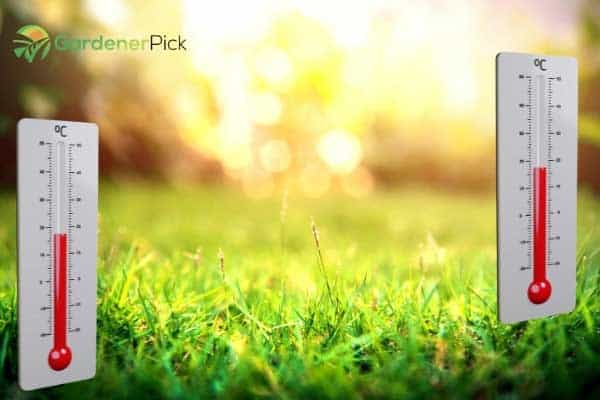Are you wondering if the grass of your lawn ever stops growing? Do you want to know at what temperature it happens? What factors are responsible for dormancy in the grass? Are you concerned about the browning of your grass during the winter?
If yes, then keep on reading this article. You’ll learn at what temperature the turf stops growing and why it happens.
Let’s figure out what temperature does grass stop growing? Normally, grass stops growing when the daytime temperature falls below 50°F. The ideal temperature for the growth of grass plants is between 50 to 65°F for cool-season grasses. While the warm season grasses grow well at temperatures between 80 to 95°F. Generally, a grass plant needs air, water, sunlight, and nutrients to grow. Below freezing temperatures, these needs of grass plants are not fulfilled and they stop growing.
The stopped growth of grass is termed seasonal dormancy. It is a natural mechanism in which the grass of your lawn goes on holidays to save itself from the effects of extreme weather. It regains strength and comes back as soon as seasonal conditions become favorable.
To learn about when and why it happens, you just need to scroll down.
Table of Contents
When Actually Grass Stops Growing or Goes Dormant?
Have you any idea when the grass stops growing? Normally, it happens during the winter when the temperature of the air remains between 5 to 12 degrees celsius (40-55°F). For the lawns in the cold regions of the UK and the U.S.A, the dormancy period of grass starts from the mid of November. For warmer regions, this period starts in December.
Mostly new gardeners think that grass completely stops growing during the dormancy time. It is actually a misconception. The growth process never ends during the dormancy, instead, it slows down. It also depends on the type of grass in your lawn whether it will cease growth or finally die. Usually, the growth of the perennial grasses slows during the winter season. On the other hand, annual ryegrass and annual meadow grass die during the extreme cold weather.
Factors Responsible For Dormancy/ Stopped Grass Growth
Normally, the grass requires favorable temperature, enough moisture, sunlight, and nutrients to grow. If any of these factors is lacking, the growth process slows down exhibiting dormancy.
Do you want to know how these factors are responsible for stopping the growth of grass? Let’s have a look below:
Temperature
The temperature is the main factor responsible for dormancy in the grasses. Usually, gardeners prefer cool-season and warm-season grasses depending on the climate of their area. The cool-season grasses include perennial ryegrass and blue fescue that grow well between 50 to 65 °F. These grasses fall into dormancy when the temperature reaches above 90 °F.
On the other hand, warm-season grasses such as Bermuda grass and St. Augustine grass will go dormant when the temperature falls below 65 °F in winter. But these grasses can revive back when the temperature becomes normal. Plus, a healthy lawn is able to survive the weather extremes.
Moisture
A sufficient water supply is a key to a healthy lawn. When the cool-season grasses are exposed to high temperatures during summer, drought stress and dry conditions induce dormancy in these grasses. The mid of summer season induces a short period of stopped growth. Such grasses can also revive back by a sufficient supply of water. Nowadays, certain drought-tolerant varieties of grass are also available. The grasses like tall fescue have a deep root system that can absorb water from deep soil, therefore making it drought tolerant.
Sunlight
The photosynthesis takes place in the presence of sunlight and makes food for the grass. From the start of the fall, less daylight is available. But the grasses require a small amount of carbon dioxide and sunlight to photosynthesize. It can be a problem when the grass is covered by snow. The below-freezing temperatures and unavailability of sunlight induce dormancy in the grass. In presence of sunlight, the soil temperature takes longer to fall, hence roots can still draw moisture from the soil.
Nutrients
When the temperature of the soil stays below 55 °F constantly, it damages the ability of the roots to absorb nutrients from the soil. Most warm-season grasses are prone to get damaged by frost and low soil temperature. When the grass blades don’t receive nutrients, the overall turf is affected. To cope with this stress period usually grasses go on vacations to regain strength and vigor.
Does Grass Stop Growing When It Is Hot
Well, most grasses cannot withstand dry conditions and hot weather. The cool-season grasses normally stop growing when the temperature goes above 90 °F. The hot weather results in a drought. Due to the lack of moisture, roots cannot provide the required moisture to the blades. As a result, the grass tends to sleep for some time. It is actually a defense mechanism of grasses. During the sleeping time, the grass puts all of its energy in its roots and gets prepared for the coming weather.
Sometimes, gardeners mistake the dying grass for the sleep phase. The browning and burned patches of your lawn indicate that something is wrong. It requires overseeding to renovate your lawn in the early spring. The ryegrass and annual meadow grass are more susceptible to dying in the hot weather. In this case, you should select a mixture of cool and hot season grasses that can withstand the harshness of weather.
What Temperature Does Grass Grow Best
You will be surprised to know that soil temperature matters a lot in the best growth of grass. The cool-season grasses grow well if the soil temperature is between 50 °F and 65°F. While the warm season grasses are at their peak growth during the summer when the temperature is between 80 to 95°F.
If you want a super lush green lawn, the selection of grass type should be according to the climate of your location. You must select the grass by keeping the hardiness zones in mind. Moreover, you should use digital soil moisture, temperature, and nutrient level meter to determine the factors that are disturbing the growth of grass plants.
Is It Better To Leave The Grass Long Or Short For Winter
Before the arrival of winter, you should set your target of the last mow to achieve 2 ½ inches height of the grass. It is an ideal height for the grass that is neither too tall nor too short. If the height of the grass is too tall, it may develop fungus and is at risk of pest infestation during the cold weather. On the other hand, too short grass can be stressed out by winter.
For pre-winter mowing, keep the following points in mind:
- Make sure the height of your grass should be 2 ½ inches during the winter.
- Avoid cutting too much grass at a time because it can weaken the root system.
- Avoid mowing during snow and rainy weather.
- If you will cut grass during frost, frozen grass leaves may result in lawn damage.
- Make sure that your lawn has proper drainage.
- You should never mow if the lawn is water lodged.
- If mowing is required, select a dry day to proceed.
- Set the blades of your mower higher( about 2 inches) than in the summer.
- Use a mower blade sharpener if necessary to sharpen the blades.
- Make sure not to cut the lawn too low, it can weaken the roots.
At What Temperature Grass Seeds Stop Germinating
Interestingly, grass seeds also feel cold and want to sleep in extremely cold weather. The soil temperature between 50 to 65°F is ideal for seeds germination. It is attained by the soil when the daytime temperature is 60 to 75 °F.
But the grass seeds don’t like the soil temperature below 50°F. During the freezing temperatures, the seeds will go dormant and not germinate. After the temperature becomes normal, they will sprout in the spring. Although these seeds are temperature resistant, irregular temperature fluctuations can kill the seeds. In this case, reseeding is required.

Does Grass Stop Growing At a Certain Height
Normally, the height of grass depends on the type of turf in your lawn. Some grasses like Tall fescue and Bluegrass grow and increase in height with time. At a certain height, they will stop growing, start forming seeds heads, and will look like weeds. It requires mowing otherwise it can serve as a hiding place for reptiles.
For tall fescue, the best mowing height is 3.5 to 4 inches, while for bluegrass, the ideal mowing height is 2.5 to 3 inches. Moreover, if any of your neighbors complained about your tall grass, you will have to pay a fine. That’s why a regular mowing schedule is necessary for maintaining the proper growth and look of your turfgrass.
Final Words
Finally, our info relating to the dormancy temperature of grass comes to an end.
The final words are, the grass normally goes on vacation if the air temperature is between 40 to 55°F in winter. While the warm season grasses switch on resting mode when the temperature goes above 90 degrees Fahrenheit.
Dormancy is a natural process that prepares the grass for peak growth in the coming season. Make sure to retain the 2 ½ inches height of your grass before winter. Plus, avoid too much mowing in winter and wait for suitable weather conditions if mowing is critical.
So, get your lawn ready for the upcoming season. A healthy and well-maintained lawn can effectively withstand the harsh effects of weather.
If you find this article helpful, don’t forget to share it with other gardeners.






